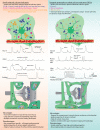Photonics tools begin to clarify astrocyte calcium transients
- PMID: 35211642
- PMCID: PMC8857908
- DOI: 10.1117/1.NPh.9.2.021907
Photonics tools begin to clarify astrocyte calcium transients
Abstract
Astrocytes integrate information from neurons and the microvasculature to coordinate brain activity and metabolism. Using a variety of calcium-dependent cellular mechanisms, these cells impact numerous aspects of neurophysiology in health and disease. Astrocyte calcium signaling is highly diverse, with complex spatiotemporal features. Here, we review astrocyte calcium dynamics and the optical imaging tools used to measure and analyze these events. We briefly cover historical calcium measurements, followed by our current understanding of how calcium transients relate to the structure of astrocytes. We then explore newer photonics tools including super-resolution techniques and genetically encoded calcium indicators targeted to specific cellular compartments and how these have been applied to astrocyte biology. Finally, we provide a brief overview of analysis software used to accurately quantify the data and ultimately aid in our interpretation of the various functions of astrocyte calcium transients.
Keywords: analysis; astrocyte; calcium; genetically encoded fluorescent calcium indicator; stimulation emission depletion; two-photon.
© 2022 The Authors.
Figures



